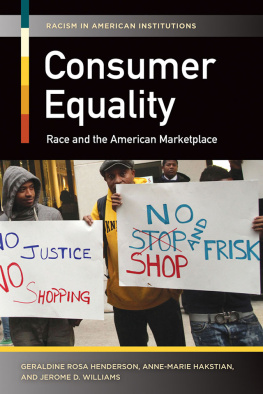This book is about race and gender discrimination at work. It is a grim subject. It is not grim because discrimination is awful (although discrimination, when it exists, is awful). The subject is grim because most discussions of discrimination, both conservative and liberal, are pretty tedious. This is a debate with a large amount of posturing and hot air. Most people have already made up their minds about this topic before they study it. Either people think discrimination is an important force in U.S. society or they dont. Once they have decided this matter, they have their speeches written and ready to give, and they dont want to hear much about material from the other side.
If you are a committed leftist or feminist, you see the world in terms of the victimization of the weak by the strong. The world is filled with gross inequalities that are the results of predation by the powerful. The poor are poor because of exploitation by the rich; blacks are poor because of discrimination by whites; women are poor because of the sexism of men.
If you are a committed conservative, you see the world in terms of bureaucratic obstacles to meritocracy. The world is full of nonperformers who use special pleadings to keep the talented and energetic from getting their just rewards. The government taxes the successful so that it can write checks to the less enterprising. Minorities seek set-asides so that they dont have to compete with majority members with better test scores and greater abilities. Women seek reverse discrimination lawsuits to counterweight their own lack of commitment to the labor force and to cloud the legitimate accomplishments of men.
Because people have made up their minds about these issues already, they prefer to ignore facts that are inconsistent with their own preconceived views. There are plenty of these facts to deal with. Race and gender in the United States are subjects that have been studied exhaustively. With these studies have come statistics that may be dry but that have a story to tell. They fit some aspects of the liberals story, some aspects of the conservatives story, and some aspects of nobodys story. The statistics that fit nobodys story are the most interesting, because they suggest that what is going on in the workplace is not what most people expect.
If there is going to be a good-faith discussion of race and sex in the workplace, it has to be done with the facts; it has to be done with the numbers. Statistics are the ultimate honesty test. You cant just take one isolated example of blatant discrimination or blatant abuse of affirmative action and wave it around in the air as if this is what happens every day all the time. What happens every day all the time is what is measured in census statistics. Census statistics are numbers that count what happens to the population as a whole. Interesting stories occur, but it is important to know what is a typical horrible situation, what is exceptional, and therefore not worth making a big fuss over.
Occasionally, national statistics do not speak to a critical issue. Then we are forced to go to the anecdotes, to the stories of what happens to particular people in particular firms. Even here, however, a little scientific discipline can depoliticize a discussion and allow for more careful consideration of the facts. There are a lot of good quantitative studies that allow one to carefully test liberal, conservative and neutral accounts of what is happening to men and women in specific companies. These studies suffer from not being economy-wide, but they gain by being able to rule out particular scenarios at particular times and places. To know that no discrimination occurred at Company X, or that at Company Y discrimination was severe against blacks but only when certain conditions occurred, helps frame a larger discussion. We can try to do as many studies of this sort as we can, collect the results from various companies, and see if the pieces of the mosaic we can find suggest what the larger picture may look like.
The studies presented here suggest that discrimination exists. It does not always take the form that many orthodox feminists and liberals claim. It does not occur for the reasons most people think it does. Discrimination is often absent from many places where it is supposed to be pervasive. Everyone knows that stereotypes about women and blacks are often false. Stereotypes about stereotyping are also false, however, and these need correction as well.
The story presented here is not the standard account of discrimination. The book provides statistics in lavish and copious detail because statistics are the only cure available for preconceptions. Most readers will probably finish the book with the same political persuasions they began with. However, if liberals can now argue a liberal position in a manner consistent with the facts, and conservatives can argue a conservative position in a manner consistent with the facts, then the book will have served its purpose.
Few things in the world are more boring than definitions. However, on controversial topics in which inflammatory language is common, developing a common agreed-upon language can take the sting and insult out of buzzwords and allow for calmer, more consensual discussion.
Ascriptive Status is a feature that one is born with. Gender, race, and ethnicityand in some cases, religion and sexual preferenceare attributes one can be born with.
Inequality is the unequal allocation of benefits. We normally study inequality among groups with different ascriptive statuses, although any subgroups can be studied in this way. Any benefit can be distributed unequally; people differ in their access to social status, leisure, relationships, and power. However, the most obvious unequally distributed resources are economic: income, jobs, and wages. Income is the total revenue that people receive. This includes salaries, bank interest, dividends, capital gains, lottery winnings, gifts, and other more obscure sources of funds. We care about income because how much money people have determines the general quality of their lives. The largest component of most peoples income is wages. This book will spend a lot of time discussing the determinants of inequality in wagesand employment matters as well, because anyone without a job has earnings of zero. Therefore this book gives a lot of attention to differences in who does or does not have a job and why.









